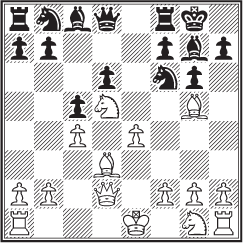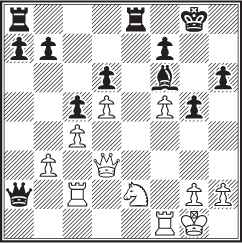
Fischer briefly played postal chess but virtually none of his games survive. One intriguing specimen is a miniature he apparently lost in Chess Review’s annual tournament, the Golden Knights, in 1955. The game A. W. Conger – B. Fischer began 1 d4 ♘f6 2 c4 g6 3 ♘c3 ♗g7 4 e4 d6 5 ♗g5 h6 6 ♗h4 0–0 7 f4 c5 8 d5 ♕a5 9 ♕d2 and now, instead of 9...e6!, he played 9...♕c7? 10 ♗d3 e6 and resigned after 11 ♘b5 ♕b6 12 ♘xd6!, although 12...♕xd6 13 e5 is not that clear. Here is a similar line.
László Szabó – Fischer
Olympiad, Leipzig 1960
King’s Indian Defense (E70)
1 |
d4 |
♘f6 |
2 |
c4 |
g6 |
3 |
♘c3 |
♗g7 |
4 |
e4 |
0–0 |
5 |
♗g5 |
|
Szabó points out a drawback to Black’s fourth move. After the normal 4...d6 Black can meet 5 ♗g5 with 5...h6 and then 6 ♗h4 c5 7 d5 ♕a5! with the idea of 8 ♕d2 g5 9 ♗g3 ♘h5! or 8 ♗d3 g5 9 ♗g3 ♘xe4! 10 ♗xe4 ♗xc3+ 11 bxc3 ♕xc3+ and 12...f5 as in a Spassky – Fischer rematch game.
But after 4...0-0 5 ♗g5 h6 White can retreat to e3 and gain a tempo later with f2-f3 and ♕d2.
5 |
... |
d6 |
6 |
♕d2 |
c5 |
7 |
d5 |
|
White is less than equal after 7 dxc5 dxc5 8 ♕xd8 ♖xd8 9 ♗xf6 ♗xf6 10 ♘d5 ♘c6 11 ♘xf6+ exf6.
7 |
... |
e6 |
8 |
♗d3 |
exd5 |
9 |
♘xd5 |
|
After 9 cxd5 a6 10 a4 ♕a5 White’s rook is undefended at a1 and therefore 11...b5 is threatened, e.g. 11 ♘ge2 b5 12 0–0 b4 or 11 ♖a3 ♖e8 12 ♘ge2 ♘bd7 13 0–0 ♘e5. The other capture, 9 exd5, is known to be unambitious in similar situations, and here White gets nothing that can pretend to be an edge after 9...♘bd7 10 f4 a6 11 a4 ♕a5 (12 ♘ge2 b5!).

9 |
... |
♗e6 |
Black plans 10...♗xd5 and doesn’t fear the backward d-pawn after 10 ♘xf6+ ♗xf6 11 ♗xf6 ♕xf6 12 ♘e2 because of the piece play he gets after 12...♘c6, e.g. 13 ♖c1 a6 14 ♘c3 ♘d4 and ...b5.
10 |
♘e2 |
♗xd5 |
But he must act before ♘ec3 reinforces the knight. After 10...♘c6 11 ♘ec3 ♘d4 12 0–0 ♖e8 13 f4! White has a splendid middlegame ahead of him.
11 |
exd5 |
|
Fischer pointed out 11 cxd5 c4! and then 12 ♗c2 (not 12 ♗xc4? ♘xe4) 12...♘bd7 13 0–0 ♘c5 14 ♘c3 b5 with excellent play.
11 |
... |
♘bd7 |
One of the knights has to find a good square now (12 f4 ♕e8! and ...♘g4 or 13...♘e4 with at least a small plus for Black).
12 |
0–0 |
♘e5 |
13 |
f4? |
|
White has equality but no more with 13 ♘c3 After 13 ♖ae1 Black succeeds in exchanging off White’s good bishop with 13...h6 14 ♗f4 ♘h5 15 ♗e3 but 15 ♗xe5! ♗xe5 16 f4 ♗g7 17 f5! is dangerous. Better is the equal 13...♘xd3.
13 |
... |
♘xd3 |
14 |
♕xd3 |
h6! |
The timing of this move in the King’s Indian makes all the difference. Once White advances f4-f5 the bishop can retreat along a better diagonal.
15 |
♗h4 |
♖e8 |
Now 16 ♘c3 ♕b6 followed by ...♘g4 (17 f5 g5 18 ♗g3 ♘g4 or 17 h3 ♘h5).
16 |
♖ae1 |
♕b6! |
In order of importance, Black’s move (a) threatens the b-pawn, (b) unpins the knight, and (c) prepares to double rooks on the e-file.
17 |
♗xf6? |
|
The hard-to-find defense was 17 b3 ♘e4 18 f5! so that 18...g5 19 ♘c1 threatens ♖xe4.
17 |
... |
♗xf6 |
18 |
f5 |
g5 |
19 |
b3 |
|
White seems to have solved his main problems and is ready for ♘g3-e4 or ♘h5. If he had safeguarded his queenside with 19 ♖b1 (to meet 19...♕a5 with 20 a3) Black would seize the e-file with 19...♖e7! 20 ♘g3 ♖ae8.
19 |
... |
♕a5! |
But this sets new problems because the main threat is not 20...♕xa2 but rather 20...♗d4+! (21 ♘xd4? ♖xe1 or 21 ♔h1 ♖e3 and ...♖ae8 with a crushing pin).
20 |
♖c1?? |
|
Fischer said the best defense was 20 ♕b1, e.g. 20...♕d2 21 ♘g3. Now the game becomes a rout.
20 |
... |
♕xa2 |
21 |
♖c2 |
|

21 |
... |
♖e3! |
Undoubtedly overlooked by Szabó. But even after 21...♕a3 it’s hard to imagine Black lasting long, e.g. 22 ♘g3 ♗d4+ 23 ♔h1 ♖e3 or 22 ♕h3 ♔h7 23 ♕h5 ♖e7 24 ♖f3 ♖ae8 25 ♖h3 ♕a1+ 26 ♔f2 ♗d4+.
22 |
♕xe3 |
♕xc2 |
23 |
♔h1 |
a5! |
24 |
h4 |
a4 |
White resigns |
||